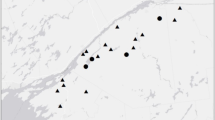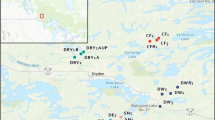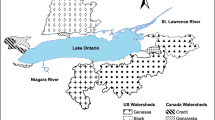Abstract
The upper Great Egg Harbor River watershed in New Jersey’s Coastal Plain is urbanized but extensive freshwater wetlands are present downstream. In 2006–2007, studies to assess levels of total mercury (THg) found concentrations in unfiltered streamwater to range as high as 187 ng/L in urbanized areas. THg concentrations were <20 ng/L in streamwater in forested/wetlands areas where both THg and dissolved organic carbon concentrations tended to increase while pH and concentrations of dissolved oxygen and nitrate decreased with flushing of soils after rain. Most of the river’s flow comes from groundwater seepage; unfiltered groundwater samples contained up to 177 ng/L of THg in urban areas where there is a history of well water with THg that exceeds the drinking water standard (2,000 ng/L). THg concentrations were lower (<25 ng/L) in unfiltered groundwater from downstream wetland areas. In addition to higher THg concentrations (mostly particulate), concentrations of chloride were higher in streamwater and groundwater from urban areas than in those from downstream wetland areas. Methylmercury (MeHg) concentrations in unfiltered streamwater ranged from 0.17 ng/L at a forest/wetlands site to 2.94 ng/L at an urban site. The percentage of THg present as MeHg increased as the percentage of forest + wetlands increased, but also was high in some urban areas. MeHg was detected only in groundwater <1 m below the water/sediment interface. Atmospheric deposition is presumed to be the main source of Hg to the wetlands and also may be a source to groundwater, where wastewater inputs in urban areas are hypothesized to mobilize Hg deposited to soils.









Similar content being viewed by others
References
Academy of Natural Sciences. (1994). Preliminary assessment of total mercury concentrations in fish from rivers, lakes, and reservoirs in New Jersey. Philadelphia, PA. Final Report 93-15F.
BAE Systems. (2003). BAE systems ADR, Digital color infrared (CIR) orthophotography of New Jersey. Trenton: New Jersey Office of Information Technology.
Balogh, S. J., Nollet, Y. H., & Swain, E. B. (2004). Redox chemistry in Minnesota streams during episodes of increased methylmercury discharge. Environmental Science and Technology, 38, 4921–4927.
Barkay, T., Gillman, M., & Turner, R. R. (1997). Effects of dissolved organic carbon and salinity on bioavailability of mercury. Applied and Environmental Microbiology, 63, 4267–4271.
Barringer, J. L., & Szabo, Z. (2006). Overview of investigations into mercury in ground water, soils, and septage, New Jersey Coastal Plain. Water Air, Soil Pollution, 175, 193–221.
Barringer, J. L., MacLeod, C. L., & Gallagher, R. A. (1997). Mercury in ground water, soils, and sediments of the Kirkwood-Cohansey aquifer system in the New Jersey Coastal Plain U.S. Geological Survey Open-File Report 95-475.
Barringer, J. L., Szabo, Z., Kauffman, L. J., Barringer, T. H., Stackelberg, P. E., Ivahnenko, T., et al. (2005). Mercury concentrations in water from an unconfined aquifer system, New Jersey Coastal Plain. Science of the Total Environment, 346, 169–183.
Barringer, J. L., Szabo, Z., Schneider, D., Atkinson, W. D., & Gallagher, R. A. (2006). Mercury in ground water, septage, leach-field effluent, and soils in residential areas, New Jersey coastal plain. Science of the Total Environment, 361, 144–162.
Barrow, N. J., & Cox, V. C. (1992). The effects of pH and chloride concentration on mercury sorption. I. By goethite. Journal of Soil Science, 43, 295–304.
Belt, K., Kaushal, S, Swan, C, Pouyat, R., & Groffman, P. (2008). The urban stream continuum: The effects of upland riparian zones and engineered “urban karst” on organic matter, contaminant fluxes and lotic ecology. National Water Quality Monitoring Council, 6th National Monitoring Conference, May 2008, Atlantic City NJ (abstract).
Brumbaugh, W. G., Krabbenhoft, D. P., Helsel, D. R., Wiener, J. G., & Echols, K. R. (2001). A national pilot study of mercury contamination of aquatic ecosystems along multiple gradients: Bioaccumulation in fish. U.S. Geological Survey Biological Science Report USGS/BRD/BSR-2001-0009.
Cai, Y., Jaffé, R., & Jones, R. D. (1999). Interactions between dissolved organic carbon and mercury species in surface waters of the Florida Everglades. Applied Geochemistry, 14, 395–407.
Dillon, P. J., & Molot, L. A. (1997). Effect of landscape form on export of organic carbon, iron, and phosphorus from forested stream catchments. Water Resources Research, 33, 2591–2600.
Driscoll, C. T., Holsapple, J., Schofield, C. L., & Munson, R. (1998). The chemistry and transport of mercury in a small wetland in the Adirondack region of New York, USA. Biogeochemistry, 40, 137–146.
Eisenreich, S. J., Franz, T., Gao, Y., Brunciak, P. & Lavorgna, C. (1998). Atmospheric deposition assessment-New Jersey—Organic compounds, trace metals, Hg, and nutrients. Cook College, Rutgers University, New Brunswick, NJ unpublished report to the New Jersey Department of Environmental Protection, on file at NJDEP, Trenton, NJ.
Engstrom, D. R., & Swain, E. B. (1997). Recent declines in atmospheric deposition in the upper Midwest. Environmental Science and Technology, 31, 960–967.
Feick, G., Horne, R. A., & Yeaple, D. (1972). Release of mercury from contaminated freshwater sediments by the runoff of road deicing salt. Science, 175, 1142–1143.
Fitzgerald, W. F., Engstrom, D. R., Mason, R. P., & Nater, E. A. (1998). The case for atmospheric mercury contamination in remote areas. Environmental Science and Technology, 32, 1–7.
Fulkerson, M., Nnadi, F. N., & Chasar, L. S. (2007). Characterizing dry deposition of mercury in urban runoff. Water, Air, and Soil Pollution, 185, 21–32.
Fusillo, T. V. (1981). Impact of suburban residential development on water resources in the area of Winslow Township, Camden County, New Jersey. U.S. Geological Survey Water-Resources Investigations Report 81–27.
Gabriel, M. C., & Williamson, D. G. (2004). Principal biogeochemical factors affecting the speciation and transport of mercury through the terrestrial environment. Environmental Geochemistry and Health, 26, 421–434.
Gavis, J., & Ferguson, J. F. (1972). The cycling of mercury through the environment. Water Research, 6, 989–1008.
Grassi, S., & Netti, R. (2000). Sea water intrusion and mercury pollution of some coastal aquifers in the province of Grosseto (Southern Tuscany—Italy). Journal of Hydrology, 237, 198–211.
Haitzer, M., Aiken, G. R., & Ryan, J. N. (2003). Binding of mercury (II) to aquatic humic substances: Influence of pH and source of humic substances. Environmental Science and Technology, 37, 2436–2441.
Horowitz, A. J., Demas, C. R., Fitzgerald, K. K., Miller, T. L. & Rickert, D. A. (1994). U.S. Geological Survey protocol for the collection and processing of surface-water samples for the subsequent determination of inorganic constituents in filtered water. U.S. Geological Survey Open File Report 94-0539, 57 p
Hurley, J. P., Benoit, J. M., Babiarz, C. L., Shafer, M. M., Andren, A. W., Sullivan, J. R., et al. (1995). Influences of watershed characteristics on mercury levels in Wisconsin rivers. Environmental Science and Technology, 29, 1867–1875.
Hurley, J. P., Cowell, S. E., Shafer, M. M., & Hughes, P. E. (1998). Tributary loading of mercury to Lake Michigan: Importance of seasonal events and phase partitioning. The Science of the Total Environment, 213, 129–137.
Kauffman, L. J., Baehr, A. L., Ayers, M. A., & Stackelberg, P. E. (2001). Effects of land use and travel time on the distribution of nitrate in the Kirkwood-Cohansey aquifer system in southern New Jersey. U.S. Geological Survey Water-Resources Investigations Report 01-4117.
Kerin, E. J., Gilmour, C. C., Roden, E., Suzuki, M. T., Coates, J. D., & Mason, R. P. (2006). Mercury methylation by dissimilatory iron-reducing bacteria. Applied and Environmental Microbiology, 72, 7919–7921.
Kolka, R. K., Grigal, D. F., Nater, E. A., & Verry, E. S. (1999a). Mercury and organic carbon relationships in streams draining forested upland/peatland watersheds. Journal of Environmental Quality, 28, 766–775.
Kolka, R. K., Nater, E. A., Grigal, D. F., & Verry, E. S. (1999b). Atmospheric inputs of mercury and organic carbon into a forested upland/bog watershed. Water, Air, and Soil Pollution, 113, 273–294.
Koterba, M. T., Andres, A. S., Vrabel, J., Crilley, D. M., Szabo, Z., DeWild, J. T., et al. (2006). Occurrence and distribution of mercury in the surficial aquifer, Long Neck peninsula, Sussex County, Delaware, 2003-04. U.S. Geological Survey Scientific Investigations Report 2006-5011.
Krabbenhoft, D. P., Benoit, J. M., Babiarz, C. L., Hurley, J. P., & Andren, A. W. (1995). Mercury cycling in the Allequash Creek watershed, northern Wisconsin. Water, Air, and Soil Pollution, 80, 425–433.
Lee, J. M., & Kim, G. (2006). A simple and rapid method for analyzing radon in coastal and ground waters using a radon-in-air monitor. Journal of Environmental Radioactivity, 89, 219–228.
Lewis, M. E., & Brigham, M. E. (2004). Low-level mercury. In F. D. Wilde, D. B. Radke, J. Gibs, & R. T. Iwatsubo (Eds.), Processing of water samples. U.S. Geological survey techniques of water-resource investigations, Book 9, Chapter A5. Reston: U.S. Geological Survey.
Lindqvist, O., Johansson, K., Aastrup, M., Andersson, A., Bringmark, L., Hovsenius, G., et al. (1991). Mercury in the Swedish environment—Recent research on causes, consequences and corrective methods. Water, Air, and Soil Pollution, 55, 1–261.
Lyons, W. B., Fitzgibbon, T. O., Welch, K. A., & Carey, A. E. (2006). Mercury geochemistry of the Scioto River, Ohio: Impact of agriculture and urbanization. Applied Geochemistry, 21, 1880–1888.
Marvin-DiPasquale, M., Agee, J., McGowan, C., Oremland, R. S., Thomas, M., Krabbenhoft, D., et al. (2000). Methyl-mercury degradation pathways: A comparison among three mercury-impacted ecosystems. Environmental Science and Technology, 34, 4908–4916.
Mason, R. P., & Sullivan, K. A. (1998). Mercury and methylmercury transport through an urban watershed. Water Research, 32, 321–330.
Mierle, G., & Ingram, R. (1991). The role of humic substances in the mobilization of mercury from watersheds. Water, Air, and Soil Pollution, 56, 349–357.
Modica, E., Buxton, H. T., & Plummer, L. N. (1998). Evaluating the source area and residence times of ground-water seepage to streams, New Jersey Coastal Plain. Water Resources Research, 34, 2797–2810.
Murphy, E., Dooley, J., Windom, H. L., & Smith, R. G., Jr. (1994). Mercury species in potable ground water in southern New Jersey. Water, Air, Soil Pollution, 78, 61–72.
NJDEP. (2007). Land use/land cover update, Great Egg Harbor Watershed Management Area WMA-15, vector digital data. Trenton: New Jersey Department of Environmental Protection, Office of Information Resources Management, Bureau of Geographic Information Systems.
NJDEP. (2008). Surface water quality standards. N.J.A.C:7:9B, June 16, 2008. www.state.nj.us/dep/wms/bwqsa/docs/0608_SWQS.pdf. Accessed 30 June 2009
Nriagu, J. O., & Pacyna, J. M. (1988). Quantitative assessment of worldwide contamination of air, water and soils by trace metals. Nature, 333, 134–139.
Olson, M. L., & DeWild, J. F. (1999). Techniques for the collection and specific analysis of low levels of mercury in water, sediment, and biota. U.S. Geological Survey Water Resources Investigations Report 99-4018B.
Parkhurst, D. L., & Appelo, C. A. J. (1999). User’s guide to PHREEQC (version 2)—A computer program for speciation, batch reaction, one-dimensional transport, and inverse geochemical calculations. U.S. Geological Survey Water Resources Investigations Report 99-4259.
Rantz, S. E., & others. (1982). Measurement and computation of streamflow: Volume 1, measurement of stage and discharge. U.S. Geological Survey Water Supply Paper 2175.
Ravichandran, M. (2004). Interactions between mercury and dissolved organic matter—A review. Chemosphere, 319, 319–331.
Ravichandran, M., Aiken, G. R., Ryan, J. N., & Reddy, M. M. (1999). Inhibition of precipitation and aggregation of metacinnabar (mercuric sulfide) by dissolved organic matter isolated from the Florida Everglades. Environmental Science and Technology, 33, 1418–1423.
Ryan, J. N., & Gschwend, P. M. (1994). Effect of solution chemistry on clay colloid release from an iron oxide-coated aquifer sand. Environmental Science and Technology, 28, 1717–1726.
Schuster, P. F., Shanley, J. B., Marvin-DiPasquale, M., Reddy, M. M., Aiken, G. R., Roth, D. A., et al. (2008). Mercury and organic carbon dynamics during runoff episodes from a northeastern USA Watershed. Water, Air, and Soil Pollution, 187, 89–108. doi:10.1007/s11270-007-9500-3.
Selvendiran, P., Driscoll, C. T., Bushey, J. T., & Montesdeoca, M. R. (2008). Wetland influence on mercury fate and transport in a temperate forested watershed. Environmental Pollution, 154, 46–55.
Shanley, J. B., Mast, M. A., Campbell, D. H., Aiken, G. R., Krabbenhoft, D. P., Hunt, R. J., et al. (2008). Comparison of total mercury and methylmercury cycling at five sites using the small watershed approach. Environmental Pollution, 154, 143–154.
Skyllberg, U., Xia, K., Bloom, P. R., Nater, E. A., & Bleam, W. F. (2000). Binding of mercury (II) to reduced sulfur in soil organic matter along upland-peat soil transects. Journal of Environmental Quality, 29, 855–865.
Sorenson, J. A., Glass, G. E., & Schmidt, K. W. (1994). Regional patterns of wet mercury deposition. Environmental Science and Technology, 28, 2025–2032.
Szabo, Z., Rice, D. E., Plummer, L. N., Busenberg, E., Drenkard, S., & Schlosser, P. (1996). Age dating of shallow ground water with chlorofluorocarbons, tritium/helium 3, and flow path analysis, southern New Jersey Coastal Plain. Water Resources Research, 32, 1023–1038.
Szabo, Z., Zapecza, O. S., Oden, J. H., & Rice, D. E. (2005a). Radiochemical sampling and analysis of shallow ground water and sediment at the BOMARC Missile Facility, east-central New Jersey, 1999–2000: U.S. Geological Survey Scientific Investigations Report 2005-5062, 87 p. [http://pubs.er.usgs.gov/pubs/sir/sir20055062]
Szabo, Z., dePaul, V. T., Kraemer, T. F., & Parsa, B. (2005b). Occurrence of radium-224 and comparison to that of radium-226 and radium-228 in water from the unconfined Kirkwood-Cohansey aquifer system, southern New Jersey. U.S. Geological Survey Scientific Investigations Report 2004-5224.
Taggart, J. E. (2002). (Ed.), Analytical methods for chemical analysis of geologic and other materials, U.S. Geological Survey. U.S. Geological Survey Open-File Report 02-223.
Urban, N. R., Bayley, S. E., & Eisenreich, S. J. (1989). Export of dissolved organic carbon and acidity from peatlands. Water Resources Research, 25, 1619–1628.
USEPA. (2001). Water quality criterion for the protection of human health: Methylmercury. Washington, D.D., U.S. Environmental Protection Agency, EPA-823-R-01-001.
Watras, C. J., Morrison, K. A., Hudson, R. J. M., Frost, T. M., & Kratz, T. K. (2000). Decreasing mercury in northern Wisconsin: Temporal patterns in bulk precipitation and a precipitation-dominated lake. Environmental Science and Technology, 34, 4051–4057.
Watt, M. K. (2000). A hydrologic primer for New Jersey watershed management. U.S. Geological Survey Water-Resources Investigations Report 00-4140.
Watt, M. K. & Johnson, M. L. (1992). Water resources of the unconfined aquifer system of the Great Egg Harbor Basin, New Jersey 1989-90. U.S. Geological Survey Water-Resources Investigations Report 91-4126.
Wilde, F. D., Radtke, D. B., Gibs, Jacob, & Iwatsubo, R. T. (2004). Processing of water samples (version 2.1). U.S. Geological Survey Techniques of Water-Resources Investigations, book 9, chap. A5, accessed 03/05 /08 at http://pubs.water.usgs.gov/twri9A5/.
Wu, F., Cai, Y., Evans, D., & Dillon, P. (2004). Complexation between Hg (II) and dissolved organic matter in stream waters: An application of fluorescence spectroscopy. Biogeochemistry, 71, 339–351.
Acknowledgments
Funds for these studies were provided by the USGS and NJDEP. The authors gratefully acknowledge Mark Brigham (USGS) and Barbara Hirst and Kimberly Cenno (NJDEP) for administrative assistance. Special thanks go to USGS colleagues Donald Rice, William Ellis, and Denis Sun for GIS and illustrative work and to Mark Brigham and Paul Schuster for helpful comments on early drafts of this paper. The authors are grateful for the insightful comments of two anonymous reviewers that led to a much improved manuscript. Any use of trade, product, or firm names is for descriptive purposes only, and does not imply endorsement by the US Government.
Author information
Authors and Affiliations
Corresponding author
Electronic supplementary materials
Below is the link to the electronic supplementary material.
Table S1
Map labels, sampling site names, and downstream site identification numbers (Station number, USGS database), Great Egg Harbor River (GEHR) watershed, New Jersey Coastal Plain (DOC 38 kb)
Table S2
Analytical methods, accuracy or precision, reporting limits for selected field parameters and constituents in unfiltered (U) and filtered (F) water samples, particulate (P) samples, and bed-sediment samples, and laboratories performing analyses (DOC 54 kb)
Rights and permissions
About this article
Cite this article
Barringer, J.L., Riskin, M.L., Szabo, Z. et al. Mercury and Methylmercury Dynamics in a Coastal Plain Watershed, New Jersey, USA. Water Air Soil Pollut 212, 251–273 (2010). https://doi.org/10.1007/s11270-010-0340-1
Received:
Accepted:
Published:
Issue Date:
DOI: https://doi.org/10.1007/s11270-010-0340-1




